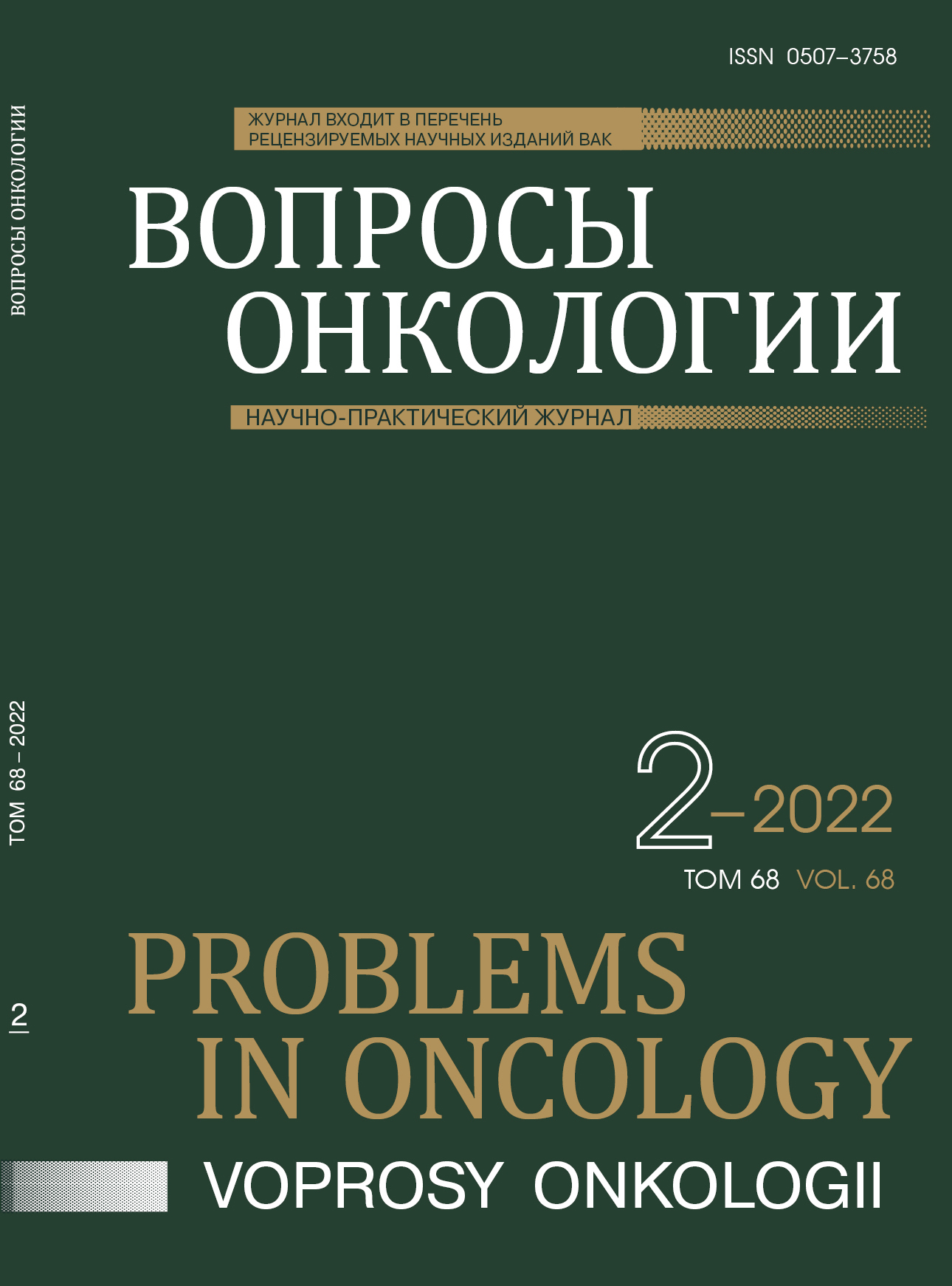Abstract
Purpose: To determine impact of various planning tumour volume (PTV) margins on final dose distribution in patients with maximal intrafraction prostate displacement.
Materials: We analyzed data of 15 prostate cancer patients with maximal (значения) prostate intrafraction displacement registered during stereotactic body radiotherapy (SBRT) — 5 fractions of 7.25 Gy. Prostate displacement was determined by cone beam CT that was performed before and after each fraction. Modeling of dose distribution considering prostate displacement was performed for every fraction by isocenter shift. Final dose distribution was calculated as the sum of all fractions and was evaluated for PTV with various margins: 5-5-5-3, 3-3-3-1, 5-5-5 and cropped rectum.
Results: The dosimetric impact of maximal intrafraction prostate motion was minimal for target coverage even for PTV with minimal margins (3 in all directions and 1 mm — posterior): CTV V100% varied from 97.5 to 100%. Prostate displacement reduced the dose to the rectum in all but minimal doses were detected for PTV 3-3-3-1: average D2cc — 31.87 Gy (28.41–34.05). For PTV 3-3-3-1 average bladder V100% volume slightly increased from 3.67 (SBRT plan) to 4.87 cc (simulation of intrafraction prostate displacement).
Conclusions: The dosimetric impact of maximal intrafraction prostate motion was minimal for target coverage and doses in rectum and bladder even for PTV with minimal (3-3-3-1) margins.
References
Meier R, Beckman A., Henning G et al. Five-year outcomes from a multicenter trial of stereotactic body radiation therapy for low- and intermediate-risk prostate cancer // Int. J. Radiat. Oncol. Biol. Phys. 2016;962):S33–S34. doi:10.1016/j.ijrobp. 2016.06.094
Lehrer EJ, Kishan AU, James B et al. Ultrahypofractionated versus hypofractionated and conventionally fractionated radiation therapy for localized prostate cancer: A systematic review and meta-analysis of phase III randomized trials // Radiotherapy and Oncology. 2020;148:235–242.
De Vries KC, Wortel RC, de Hoop EO et al. Hyprofractionated versus conventionally fractionated radiotherapy for patients with intermediate — or high-risk, localized, prostate cancer: 7-year outcomes from the randomized, multi-centre, open-label, phase 3 HYPRO trial // Int. J. Radiat. Oncol. Biol. Phys. 2020;106(1):108–115.
Datta NR, Stutz E, Rogers S, Bodis S. Conventional versus hypofractionated radiation therapy for localized or locally advanced prostate cancer: a systematic review and meta-analysis along with therapeutic implications // Int. J. Radiat. Oncol. Biol. Phys. 2017;99(3):573–589.
Sanda MG, Dunn RL, Michalski J et al. Quality of life and satisfaction with outcome among prostate-cancer survivors // N. Engl. J. Med. 2008;358:1250–61. doi:10.1056/NEJMoa074311
Beltran C, Herman MG, Davis BJ. Planning target margin calculations for prostate radiotherapy based on intrafraction and interfraction motion using four localization methods // Int J Radiat Oncol Biol Phys. 2008;70:289–95. doi:10.1016/j.ijrobp.2007.08.040
de Muinck Keizer DM, Kerkmeijer LGW, Willigenburg T et al. Prostate intrafraction motion during the preparation and delivery of MR-guided radiotherapy sessions on a 1.5T MR-Linac // Radiother. Oncol. 2020;151:88–94.
Novikov SN, Kanaev S, Melnik J et al. Assessing the dosimetric impact of intra-fractional prostate motion during SBRT // Radiotherapy and Oncology. 2018;127:S416–S417.
Канаев С.В., Новиков С.Н., Мельник Ю.С. и др. Методология стереотаксической лучевой терапии рака предстательной железы // Вопросы онкологии. 2017;63(5):287–293.
Alongi F, Fiorentino A, De Bari B. SBRT and Extreme Hypofractionation: A New Era in Prostate Cancer Treatments? // Rep. Pract. Oncol. Radiother. 2015;20(6):411–6.
Trevor J. Royce, Panayiotis Mavroidis, Kyle Wang et al. Tumor Control Probability Modeling and Systematic Review of the Literature of stereotactic Body Radiation Therapy for Prostate Cancer // Int. J. Radiation. Oncol. Biol. Phys. 2020:1e10.
Hoffman KE, Voong KR, Levy LB et al. Randomized trial of hypofractionated dose-escalated intensity modulated radiation therapy versus conventionally fractionated intensity modulated radiation therapy for localized prostate cancer // Int. Radiat. Oncol. Biol. Phys. 2016;96:S32
Freeman DE, King CR. Stereotactic body radiotherapy for low-risk prostate cancer: five-year outcomes // Radiat. Oncol. 2011;6:3. doi:10.1186/1748-717X-6-3
Levin-Epstein RG, Jiang NY, Wang X et al. Dose-response with stereotactic body radiotherapy for prostate cancer: A multi-institutional analysis of prostate-specific antigen kinetics and biochemical control // Radiotherapy and Oncology. 2021;154:207–213.
Zelefsky MJ, Goldman DA, Hopkins M et al. Predictors for post-treatment biopsy outcomes after prostate stereotactic body radiotherapy // Radiotherapy and Oncology. 2021;159:33–38.
Kuban DA, Levy LB, Cheung MR et al. Long-term failurepatterns and survival in a randomized dose-escalation trialfor prostate cancer. Who dies of disease? // Int. J. Radiat. Oncol. Biol. Phys. 2011;79(5):1310–7. doi:10.1016/j.ijrobp.2010.01.006
Fiorino C, Cozzarini C, Vavassori V et al. Relationshipsbetween DVHs and late rectal bleeding after radiotherapy forprostate cancer: analysis of a large group of patients pooledfrom three institutions // Radiother. Oncol. 2002;64(1)
Boladerasa A, Ferrera F, Navarroa V et al. Association between EBRT dose volume histograms and quality of life in prostate cancer patients // Reports of practical oncology and radiotherapy. 2018;2(3):360–368.
Alayed Y, Cheung P, Vesprini D et al. SABR in High-Risk Prostate Cancer: Outcomes From 2 Prospective Clinical Trials With and Without Elective Nodal Irradiation // Int. J. Radiat. Oncol. Biol. Phys. 2019;104(1):36–41. doi:10.1016/j.ijrobp.2018.11.011
Kole TP, Nichols RC, Lei S et al. A dosimetric comparison of ultra-hypofractionated passively scattered proton radiotherapy and stereotactic body radiotherapy (SBRT) in the definitive treatment of localized prostate cancer // Acta Oncologica, 2015;54:825–831.
Azcona JD, Xing L, Xin Chen et al. Assessing the Dosimetric Impact of Real-Time Prostate Motion During Volumetric Modulated Arc Therapy // Int. J. Radiat. Oncol. Biol. Phys. 2014;88(5):1167–1174. doi:10.1016/j.ijrobp.2013.12.015
Jaccard M, Ehrbar S, Miralbell R et al. Single-fraction prostate stereotactic body radiotherapy: Dose reconstruction with electromagnetic intrafraction motion tracking // Radiotherapy and Oncology. 2021;156:145–152.
Xie Y, Djajaputra D, King CR et al. Intrafractional Motion of the Prostate During Hypofractionated Radiotherapy // Int. J. Radiat. Oncol. Biol. Phys. 2008;72(1):236–246. doi:10.1016/j.ijrobp.2008.04.051
Kontaxis C, de Muinck Keizer DM, Kerkmeijer LGW et al. Delivered dose quantification in prostate radiotherapy using online 3D cine imaging and treatment log files on a combined 1.5T magnetic resonance imaging and linear accelerator system // Phys. Imaging. Radiat. Oncol. 2020;15:23–9.

This work is licensed under a Creative Commons Attribution-NonCommercial-NoDerivatives 4.0 International License.
© АННМО «Вопросы онкологии», Copyright (c) 2022
